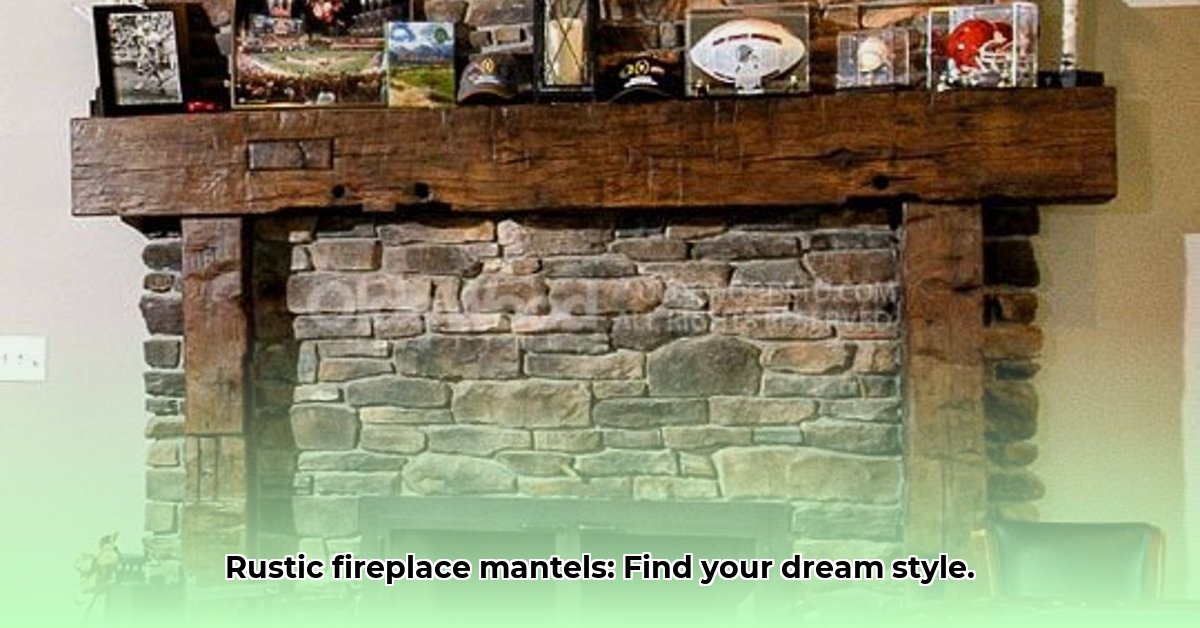Ready to give your fireplace a rustic makeover? Choosing a mantel can feel tricky, but it doesn’t have to be! This guide breaks down everything you need to know, from the different types of wood and stone to how to actually put it up. We’ll show you how to pick the perfect mantel to match your style, give you step-by-step instructions, and even share some secrets to getting the best price. Let’s create that cozy, inviting fireplace you’ve always dreamed of – without the headache. For even more inspiration, check out these [reclaimed wood mantels](https://www.wavesold.com/reclaimed-mantel/).
Rustic Mantel Selection: Styles, Materials, and Design
So, you’re ready to add the perfect finishing touch to your fireplace: a rustic mantel! More than just a shelf, it’s a statement piece, setting the tone for your entire room. Choosing the right one can feel overwhelming with so many options. Let’s explore styles, materials, and design considerations to help you find your dream mantel. A well-chosen mantel can increase home value and elevate your home’s interior.
Choosing the Right Material
The material you choose dictates the overall look and feel of your rustic mantel. Each option brings unique character and practical considerations. Let’s explore popular choices:
Reclaimed Wood: A Story in Every Grain: Reclaimed wood mantels are popular for good reason. Imagine a weathered barn beam, now gracing your fireplace, filled with history. The beauty lies in its imperfections – knots, color variations, and textures that tell a story. It’s a sustainable, eco-friendly choice, breathing rustic charm into your home. Reclaimed wood can be pricey, and supply can be limited. Embrace the variations in color and texture; that’s part of its appeal! Sourcing from reputable suppliers ensures you’re getting authentic reclaimed wood.
Stone: Timeless Elegance and Rugged Durability: Stone mantels exude permanence and sophistication. Whether you prefer fieldstone, limestone, or slate, stone offers unparalleled durability. It’s a bold statement piece that will last for generations. Stone mantels are typically heavier and more expensive than wood, and installation often requires professional help. Consider the fireplace’s structure and the room’s overall design when choosing a stone.
Engineered Wood: The Smart and Stylish Alternative: If you love the look of reclaimed wood but are on a budget, engineered wood is a fantastic option. It offers a convincing rustic look, mimicking textures and appearance without the hefty price tag or supply issues. It’s a more consistent product, meaning less variation than reclaimed wood. Some feel it lacks the unique character of a genuinely reclaimed counterpart. Look for engineered wood with realistic textures and finishes.
Other Options to Consider: Beyond these three, explore concrete, metal, or a combination of materials. Concrete can provide a modern industrial rustic vibe, while metal can add a unique style. A combined mantel might feature a reclaimed wood top supported by metal brackets, offering a blend of styles and textures. Consider how these materials blend with your existing décor.
Styles That Speak Volumes
The style of your mantel should complement your overall home decor. Do you dream of a cozy farmhouse, a romantic French country escape, or a rugged mountain lodge? Your choice of mantel should reflect that vision.
Farmhouse Charm: Farmhouse-style mantels are characterized by clean lines, simple designs, and often a painted finish. They’re versatile, blending with various décor styles. Think simple shelving, perhaps slightly distressed white paint, or a natural wood finish. Accessorize with vintage finds or natural elements.
French Country Romance: If you adore old-world elegance, a French country-style mantel is perfect. Expect delicate carvings, lighter woods like oak or pine, and often a distressed or whitewashed finish. Delicate details and a softer aesthetic create a romantic and inviting focal point. Pair with floral arrangements or antique mirrors.
Lodge Style Ruggedness: For a masculine statement, a lodge-style mantel is your best bet. Think dark, rich woods like walnut or cherry, heavy beams, and possibly even antler accents. This style brings warmth and a sense of the outdoors. It’s perfect for cabins, hunting lodges or homes with a similar rustic aesthetic. Consider adding stone accents or natural textures.
Before you choose, consider your existing furniture and decor. Aim for a cohesive look — a beautifully crafted mantel can connect your existing pieces effortlessly. Pay attention to details like brackets, corbels, and finishes.
Installation and Care
While installing a rustic mantel can be a DIY project, some caution is worthwhile. Larger or heavier mantels, especially stone ones, are best left to professionals. For lighter mantels, proper support is crucial. Ensure the mantel is level and securely attached to the wall.
Simplified Installation Guide:
- Precise Measurements: Measure your fireplace opening meticulously. Measure twice, measure thrice – accuracy is key! Account for any fire codes or safety regulations.
- Secure Mounting: Use appropriate hardware and techniques for your chosen material. Ensure the mantel is firmly and securely attached to the wall. Consult a professional for advice if you’re unsure. Use a stud finder to locate wall studs for secure attachment.
- Ongoing Care: Regularly dust your mantel. Use appropriate cleaning products for your material (avoid harsh chemicals). For wood mantels, a protective sealant is a worthwhile investment. Polish stone mantels to maintain their sheen.
Weighing the Pros and Cons
Let’s summarize the advantages and disadvantages of our popular material options:
| Material | Pros | Cons |
|---|---|---|
| Reclaimed Wood | Unique character, sustainable, adds warmth and charm, visually appealing | Higher cost, variations in color/texture, limited availability |
| Stone | Durable, timeless elegance, makes a bold statement, lasting impression | Heavy, expensive, potentially difficult installation, may require professionals |
| Engineered Wood | Cost-effective, consistent appearance, readily available, easy to install | May lack the unique character of reclaimed wood, might not be as durable |
Remember, your rustic fireplace mantel is an investment. Weigh the pros and cons carefully, consider your budget and skill level, and most importantly, choose a piece you truly love. It’s the heart of your room, a place where memories are made. Invest time & thought to select the right mantel.
Sustainable Sourcing Options for Rustic Fireplace Mantels
Choosing a reclaimed wood mantel adds rustic charm and eco-consciousness to your home. But where do you find the perfect piece? How to source sustainable reclaimed wood for rustic fireplace mantels requires careful planning. Let’s dive in.
Understanding Your Needs
Before you even think about sourcing, consider your fireplace’s dimensions. Measure carefully! You’ll need a mantel that fits proportionally and complements your existing hearth. Think about the style you desire — a chunky, substantial beam or something more delicate? Understanding your aesthetic preferences helps narrow down your search. Consider the mantel’s purpose (decorative vs. functional) and the weight it needs to bear.
Identifying Reputable Suppliers
This is where the real work begins. Don’t just settle for the first supplier you find. Research is key. Look for companies specializing in reclaimed wood offering certifications demonstrating sustainable practices. Ask probing questions. Where did the wood originate? What was its previous life? What treatments or processes have they applied? Transparency is key. Inquire about the wood’s chain of custody and environmental impact.
- Check online reviews and ratings. Do they have a consistent track record of quality materials and customer satisfaction?
- Visit their facility in person (if possible). Inspect their inventory and assess their operations firsthand. This allows you to vet the quality and ethical approach. Observe their storage practices and commitment to sustainability.
- Request detailed information on the wood’s age, origin, and treatment. Understanding the wood’s history will inform its durability and suitability. Ask for documentation or certifications verifying the wood’s origin.
Exploring Sourcing Options
Several avenues exist for finding sustainable reclaimed wood. Each offers different advantages.
- Architectural salvage yards: These are treasure troves of unique architectural elements, often including stunning reclaimed wood mantels. Explore local salvage yards for unique finds.
- Online marketplaces: Websites specializing in reclaimed lumber or architectural salvage can offer a wider selection. Be diligent and ask the right questions. Use reputable online marketplaces with secure payment options.
- Local demolition companies: Inquire about upcoming projects that might yield reclaimed wood. This approach often yields highly unique pieces. Establish relationships with demolition companies for first access.
- Barn dismantlers: Barns are a common source of beautiful, aged wood. Partnering directly with a company specializing in dismantling historic barns allows for a much deeper understanding of provenance. Look for barn dismantlers who prioritize responsible demolition practices.
Assessing Wood Quality
Once you’ve identified potential suppliers and pieces, careful inspection is crucial. Don’t be afraid to ask questions and request additional photos or videos.
- Check for structural integrity. Look for cracks, rot, or insect infestation. You need a solid, durable mantel. Examine the wood for excessive warping or twisting.
- Evaluate the wood type. Some types are better suited for mantels than others due to durability and fire resistance. Research different wood species and their suitability for fireplace mantels.
- Consider the wood’s moisture content. Excessive moisture can lead to warping and cracking later. Reputable suppliers will know moisture content. Use a moisture meter to assess the wood’s moisture content.
- **Ask about any treatments applied
- Contemporary Kitchen Backsplash Ideas for a Stylish Home - December 20, 2025
- Modern Kitchen Backsplash Ideas To Inspire Your Refresh - December 19, 2025
- Modern Backsplash Ideas: A Guide to Todays Kitchen Trends - December 18, 2025










